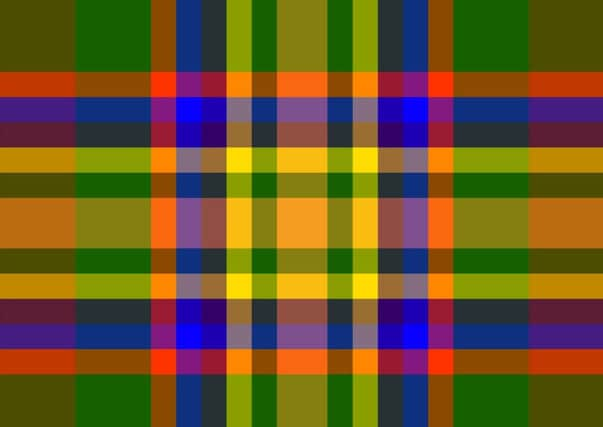Tartan genes: Colour schemes based on artist’s DNA


Jim Pattison, an honorary research fellow at the University of Dundee, colour-coded the results of the DNA tests he got back from the kit, which is sold by a firm based in the US.
Pattison, 59, used complex data from American company 23andMe after noticing the similarity between the colour strips method of recording tartans and the strip notation used to describe genetic markers that can identify individuals or animal species.
Advertisement
Hide AdPattison sent a sample of his saliva in a test tube to the US and six weeks later he received the results. They offered him reports on more than 100 health and personal traits based on the genetic test carried out on his sample and allowed him to browse the raw code of his genome.
While it cannot diagnose disease, the firm – founded by Anne Wojcicki, the wife of Google’s co-founder Sergey Brin – can reveal whether someone possesses the genetic variant of 43 hereditary conditions, including cystic fibrosis, sickle cell anaemia and any of 11 genetic risk factors for diseases such as breast cancer and Parkinson’s disease.
The test can expose 38 physical traits common to a person’s family, such as ear wax type, hair curl and pain sensitivity, and can also tell what percentage of Neanderthal a person has.
Although he admitted to being a “bit nosey” about his results, Pattison did the test specifically to gather enough information for his Genetic Tartans work, which he regards as uniquely personal, tapping into his 90-year-old mother Margaret’s connection with kilt-making and investigating new ways of producing an authentic assigned tartan.
Pattison, who received funding for his project from the Wellcome Trust charity, is now set to showcase his work with two exhibitions – at the Mitchell Library in Glasgow in June, and the Old Gala House in Galashiels in September, to acknowledge the Border town’s strong links with the textiles industry.
He said: “When I first had the idea of making tartan from my DNA, I wasn’t very sure how to go about it.
Advertisement
Hide Ad“I’d done a project before with a friend who’s a neuroscientist and he put me on to a geneticist a couple of years ago.
“The geneticist suggested I go down the 23andMe route as it’s a simplified version of genome testing.
Advertisement
Hide Ad“I used the results I got back which included a series of letters outlining the make-up of my DNA. I selected colours based on the letters and used them to design tartan setts and pattern sticks.”
Pattison – who was amused to be told he is 2.7 per cent Neanderthal – said he was inspired to start his project after talking to his mother.
He said: “Ever since I can remember she’s made kilts for family and friends. She’s asked me if I want a kilt made but the family name Pattison doesn’t have a tartan of its own (we can use Lamont), which is one of the reasons I’ve declined.
“The aim of my project is to create tartans that are unique to each individual.”
The firm launched in 2008 but its personal genome service was banned by the US Food and Drug Administration in 2013 for medical guidance reasons and because of the accuracy of the data gathered.
The UK Department of Health has said it backs the idea of using gene tests to guide patient care within the NHS, but urged any users to give careful consideration before opting for services such as the one offered by 23andMe.